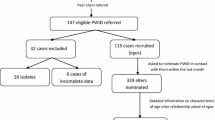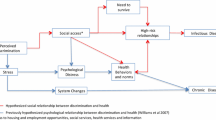Abstract
The purpose of this study was to examine the association between social network characteristics and peer norms related to sharing needles and shooting gallery use. Multivariate logistic regression modeling was used to identify factors that were independently associated with shooting gallery use among a sample of injection drug users recruited in Baltimore, Maryland. Of 842 study participants, 35% reported attending a shooting gallery in the past 6 months. Social networks of shooting gallery users were larger, had a greater number of injectors and crack smokers, were younger and less dense with fewer kin members compared to networks of non-gallery attenders. A greater proportion of those who used a gallery perceived that their peers shared needles and that peers would not disapprove if they used a dirty needle. Future research is needed to understand how social networks and peer norms are specific to behavioral settings and how this may impede adoption of preventive behaviors.
Similar content being viewed by others
References
Celentano DD, Vlahov D, Cohn S, Anthony JC, Solomon L, Nelson KE. Risk factors for shooting gallery use and cessation among intravenous drug users. Am J Public Health. 1991;81:1291–5.
Kimber J, Dolan K. Shooting gallery operation in the context of establishing a medically supervised injecting center: Sydney, Australia. J Urban Health. 2007;84:255–66.
Parkin S, Coomber R. Informal ‘Sorter’ Houses a qualitative insight of the ‘shooting gallery’ phenomenon in a UK setting. Health Place. 2009;15(4):981–9.
Reyes JC, Robles RR, Colon HM, Freeman DH, Sahai H, Matos TD. Risk factors for shooting gallery use among drug injectors in Puerto Rico. PR Health Sci J. 1996;15:227–31.
Philbin M, Pollini RA, Ramos R, et al. Shooting gallery attendance among IDUs in Tijuana and Ciudad Juarez, Mexico: correlates, prevention opportunities, and the role of the environment. AIDS Behav. 2008;12:552–60.
Grund JP, Friedman SR, Stern LS, et al. Syringe-mediated drug sharing among injecting drug users: patterns, social context and implications for transmission of blood-borne pathogens. Soc Sci Med. 1996;42:691–703.
Koester S, Glanz J, Baron A. Drug sharing among heroin networks: implications for HIV and hepatitis B and C prevention. AIDS Behav. 2005;9:27–39.
Thiede H, Hagan H, Campbell JV, et al. Prevalence and correlates of indirect sharing practices among young adult injection drug users in five U.S. cities. Drug Alcohol Depend. 2007;91(Suppl 1):S39–47.
Rhodes T. Risk environments and drug harms: a social science for harm reduction approach. Int J Drug Policy. 2009;20:193–201.
Wylie JL, Shah L, Jolly AM. Demographic, risk behaviour and personal network variables associated with prevalent hepatitis C, hepatitis B, and HIV infection in injection drug users in Winnipeg, Canada. BMC Public Health. 2006;6:229.
Latkin C, Mandell W, Vlahov D, Oziemkowska M, Celentano DD. People and places: behavioral settings and personal network characteristics as correlates of needle sharing. J Acquir Immune Defic Syndr Hum Retrovirol. 1996;13:273–80.
Latkin CA, Davey MA, Hua W. Social context of needle selling in Baltimore, Maryland. Subst Use Misuse. 2006;41:901–13.
Fitzgerald JL. Mapping the experience of drug dealing risk environments: an ethnographic case study. Int J Drug Policy. 2009;20:261–9.
Sherman SG, Latkin CA. Drug users’ involvement in the drug economy: implications for harm reduction and HIV prevention programs. J Urban Health. 2002;79:266–77.
Friedman SR, Aral S. Social networks, risk-potential networks, health, and disease. J Urban Health. 2001;78:411–8.
Latkin CA, Forman V, Knowlton A, Sherman S. Norms, social networks, and HIV-related risk behaviors among urban disadvantaged drug users. Soc Sci Med. 2003;56:465–76.
De P, Cox J, Boivin JF, Platt RW, Jolly AM. Rethinking approaches to risk reduction for injection drug users: differences in drug type affect risk for HIV and hepatitis C virus infection through drug injecting networks. J Aquir Immune Defic Syndr. 2007;46:355–61.
Shaw SY, Shah L, Jolly AM, Wylie JL. Determinants of injection drug user (IDU) syringe sharing: the relationship between availability of syringes and risk network member characteristics in Winnipeg, Canada. Addiction. 2007;102:1626–35.
Unger JB, Kipke MD, De Rosa CJ, Hyde J, Ritt-Olson A, Montgomery S. Needle-sharing among young IV drug users and their social network members: the influence of the injection partner’s characteristics on HIV risk behavior. Addict Behav. 2006;31:1607–18.
Latkin CA, Hua W, Tobin K. Social network correlates of self-reported non-fatal overdose. Drug Alcohol Depend. 2004;73:61–7.
Latkin CA, Kuramoto SJ, Davey-Rothwell MA. Tobin KE. AIDS Behav: Social norms, social networks and HIV risk behavior among injection drug users; 2009.
Cialdini RB, Reno RR, Kallgreen CA. A focus theory of normative conduct: recycling the concept of norms to reduce littering in public places. J Pers Soc Psych. 1990;58:1015–26.
Magura S, Grossman JI, Lipton DS, et al. Determinants of needle sharing among intravenous drug users. Am J Public Health. 1989;79:459–62.
Andia JF, Deren S, Robles RR, Kang SY, Colon HM. Peer norms and sharing of injection paraphernalia among Puerto Rican injection drug users in New York and Puerto Rico. AIDS Educ Prev. 2008;20:249–57.
Davey-Rothwell MA, Latkin CA. Gender differences in social network influence among injection drug users: perceived norms and needle sharing. J Urban Health. 2007;84:691–703.
Albarracin D, Johnson BT, Fishbein M, Muellerleile PA. Theories of reasoned action and planned behavior as models of condom use: a meta-analysis. Psychol Bull. 2001;127:142–61.
Latkin C, Mandell W, Vlahov D, Oziemkowska M, Knowlton A, Celentano D. My place, your place, and no place: behavior settings as a risk factor for HIV-related injection practices of drug users in Baltimore, Maryland. Am J Community Psychol. 1994;22:415–30.
Zeger SL, Liang KY. Longitudinal data analysis for discrete and continuous outcomes. Biometrics. 1986;42:121–30.
Suh T, Mandell W, Latkin C, Kim J. Social network characteristics and injecting HIV-risk behaviors among street injection drug users. Drug Alcohol Depend. 1997;47:137–43.
Dickson-Gomez JB, Knowlton AK, Latkin CA. Values and identity: the meaning of work for injection drug users involved in a volunteer HIV prevention outreach. Subst Use Misuse. 2004;39:1259–86.
Page JB, Llanusa-Cestero R. Changes in the “get-off”: social process and intervention in risk locales. Subst Use Misuse. 2006;41:1017–28.
Robles RR, Marrero CA, Reyes JC, et al. Risk behaviors, HIV seropositivity, and tuberculosis infection in injecting drug users who operate shooting galleries in Puerto Rico. J Acquir Immune Defic Syndr Hum Retrovirol. 1998;17(5):477–83.
Kerr T, Small W, Johnston C, Li K, Montaner JS, Wood E. Characteristics of injection drug users who participate in drug dealing: implications for drug policy. J Psychoactive Drugs. 2008;40:147–52.
Brady JE, Friedman SR, Cooper HLF, Flom PL, Tempalski B, Gostnell K. Estimating the prevalence of injection drug users in the US and in Large US metropolitan areas from 1992 to 2002. J Urban Health. 2008;85:323–51.
Tempalski B, McQuie H. Drugscapes and the role of place and space in injection drug use-related HIV risk environments. Int J Drug Policy. 2009;20:4–13.
Acknowledgments
This research was funded through a grant from the National Institutes of Drug Abuse R01 DA016555.
Author information
Authors and Affiliations
Corresponding author
Rights and permissions
About this article
Cite this article
Tobin, K.E., Davey-Rothwell, M. & Latkin, C.A. Social-Level Correlates of Shooting Gallery Attendance: A Focus on Networks and Norms. AIDS Behav 14, 1142–1148 (2010). https://doi.org/10.1007/s10461-010-9670-7
Published:
Issue Date:
DOI: https://doi.org/10.1007/s10461-010-9670-7




